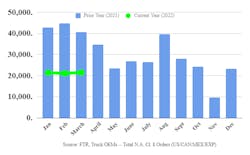Backlogs and supply constraints kept March Class 8 truck and tractor orders around the same level they’ve been at all year, according to two commercial vehicle market research firms that released preliminary data.
North American Class 8 net orders totaled 21,500 units in March, according to FTR Transportation Intelligence’s preliminary numbers, which represent a 3% increase over February's orders and a 47% drop compared to March 2021. ACT Research pegged the March Class 8 sales at 21,300 units.
Heavy-duty truck orders have varied by fewer than 400 units a month in 2022—with March activity close to the average of 21,300 for the previous seven months, according to FTR. Class 8 orders totaled 300,000 units over the last 12 months (25,000 monthly average). ACT noted that North American medium-duty orders, which it considers Classes 5 to 7 vehicles, rose to 21,200 units from 18,300 in February.
“Long backlogs and supply-chain constrained production activity kept new order activity trending within a narrow range,” Kenny Vieth, ACT president and senior analyst, said. “Based on preliminary March inputs, North American Classes 5-8 net orders were up slightly compared to February. And while orders have been moving sideways for most of two quarters, March’s intake was the best since October.”
OEMs have been taking orders one month at a time, to keep bookings just under current production rates and keep total backlogs in check, according to FTR analysis. Orders are expected to hover around this range until OEMs have more confidence in the supply chain.
“The March order total reflects a market frozen in place,” Don Ake, FTR VP of commercial vehicles, said. “All the OEMs are evaluating the business environment monthly and only entering enough orders to fill in about a month’s worth of production in the schedule. March’s number indicates that production levels stayed flat.”
ACT’s Vieth called March’s Class 8 orders “a virtual carbon copy of February’s order intake.” He noted that Class 8 backlogs stretch through 2022 with no clear sign of easing, which is why OEMs are being conservative and “looking to limit the risk of overbooking and underbuilding that plagued the industry in 2021.”
While fleet demand for new vehicles remains strong, production has been hampered by semiconductor and other component shortages. OEM and supplier labor shortages are also part of the problem. “This trend began seven months ago and has not varied much,” Ake added. “Once supply chain issues improve, OEMs will be able to substantially increase orders. But until then, conditions remain stagnant.”
Automakers are still reporting that computer chip supplies are tight, but there are expectations of supply chain improvements later this year, Ake added.
Vieth said that recent economic news around freight and freight rate data has been less positive. “We reiterate that the ground rules of ACT’s OEM data collection remain the biggest constraint on orders presently: The OEMs only report orders that are scheduled to be built within 12 months,” he explained. “With the Class 8 backlog-to-build ratio at 11 months in February and the medium-duty backlog-to-build ratio at around eight months, order volumes since early Q4 ’21 have largely been mirroring production activity. In both cases, backlog-to-build ratios are essentially double normalized levels.”
Regarding medium-duty orders and production, Vieth said that with Classes 5 to 7 backlogs remaining “just below all-time levels in February, order moderation continued into March.”
ACT’s State of the Industry: Classes 5-8 Vehicles report will be published later this month. It provides a deeper look at the current production, sales, and general state of the on-road heavy- and medium-duty commercial vehicle markets in North America. FTR’s final March data will be available later in the month as part of its North American Commercial Truck & Trailer Outlook service.




